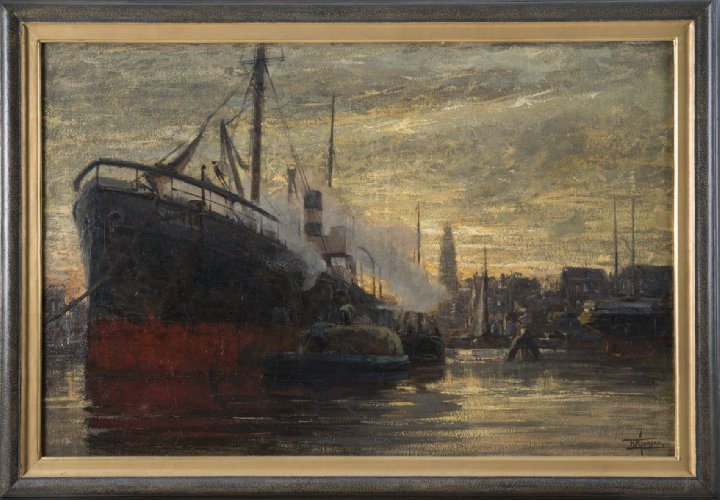Description:
Born in the Netherlands, Hendrik Willebrord Jansen (1855-1908) trained in the Amsterdam Academy in the studios of Augustus Allebé and Barend Wijnveld. At the beginning of the twentieth century he was one of the most famous artists in his country. In 1895, three years after moving to Amsterdam, he married his student Sophie Grothe, with whom he shared a workshop at Jacob van Lennepstraat 55. He also often worked outdoors, sketching views of the harbor and shipyard from a rowing boat. The remaining repertoire of themes includes summer and winter waterfronts, riverscapes, urban watery nooks and crannies, and genre scenes related to the city of Katwijk, which he often visited with his wife. Jansen‘s works were exhibited at the Salon Société des Artistes Français, as well as in Munich and Berlin. For several years he held the position of president of the Dutch artists‘ association “Arti et Amicitiae“.
The painting description:
“In the Amsterdam dock” shows the moment of unloading a ship in the port basin. On the left side of the image field we can see a black, massive hull of a steamer, from whose chimney steam is coming out. So we can be sure that as soon as the crew places all the packages in the cockpit, “Stella” will set off on her further journey. On the boat, right next to the left side of the boat, we recognize two men preparing the cargo. It is so large that one of them is on top of it. In the bent position he is fastening the hook on the consignment, the fragment of which we can see above the silhouette of the figure. The second one, with his back to the viewer, is helping to secure the shipment. The scene takes place in the light of the setting sun. Its warm colors spread across the sky above the panorama of the city, forming the compositional background for the presentation. Part of the rays are reflected on the surface of the water in the lower right corner of the painting.
The feeling of depth is built by the converging perspective. The lowered viewpoint suggests that for this work, the artist may have made a sketch while sitting in the mentioned rowboat. If we look more closely at the canvas surface, we can see bright fragments of the landscape, on which the view was probably painted. This technique also reveals the cracked layer of paint, e.g. on the hull of the ship. Although the work was done entirely in oil technique, one can get the impression of the use of pastels in the part of the sky. These thin lines were probably applied with a dry brush, which contributed to the effect of extracting the depth of the background from the substrate on the basis of contrasts.


